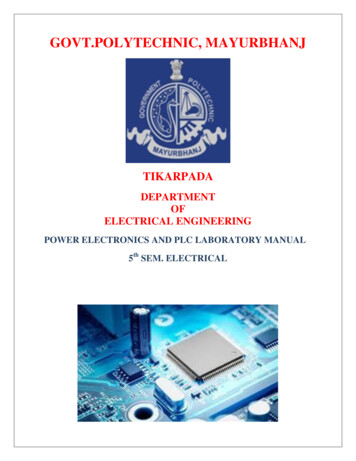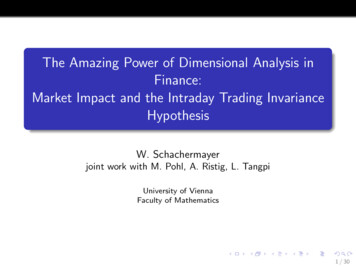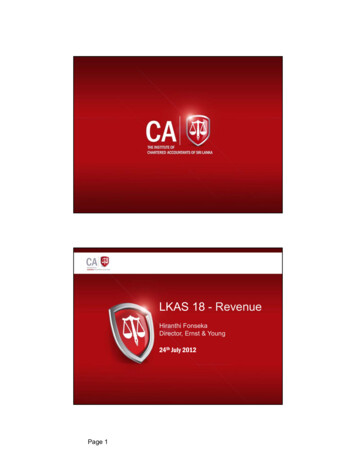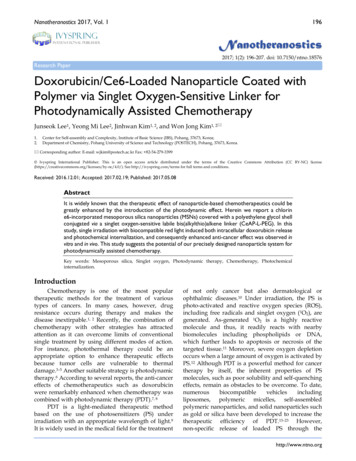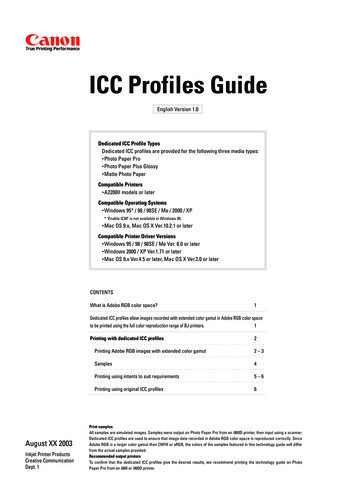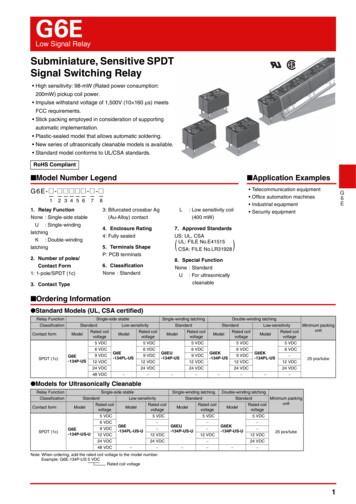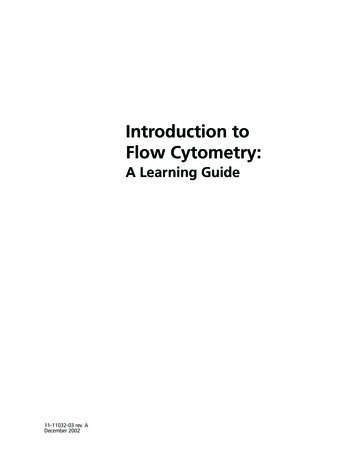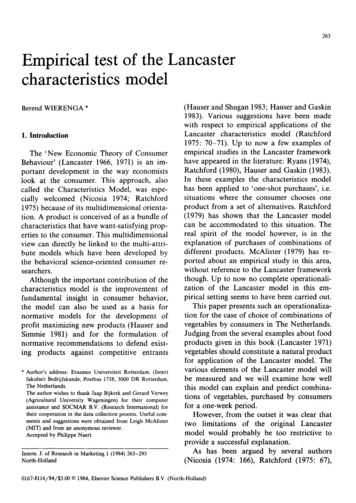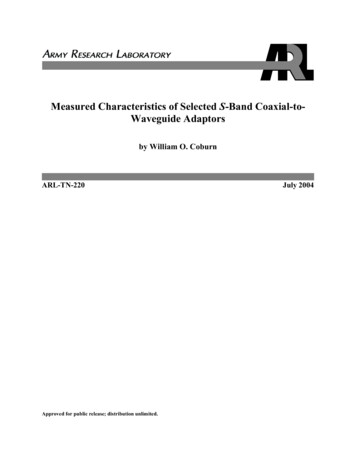
Transcription
Measured Characteristics of Selected S-Band Coaxial-toWaveguide Adaptorsby William O. CoburnARL-TN-220Approved for public release; distribution unlimited.July 2004
NOTICESDisclaimersThe findings in this report are not to be construed as an official Department of the Army positionunless so designated by other authorized documents.Citation of manufacturer’s or trade names does not constitute an official endorsement orapproval of the use thereof.Destroy this report when it is no longer needed. Do not return it to the originator.
Army Research LaboratoryAdelphi, MD 20783-1197ARL-TN-220July 2004Measured Characteristics of Selected S-Band Coaxial-toWaveguide AdaptorsWilliam O. CoburnSensors and Electron Devices Directorate, ARLApproved for public release; distribution unlimited.
Form ApprovedOMB No. 0704-0188REPORT DOCUMENTATION PAGEPublic reporting burden for this collection of information is estimated to average 1 hour per response, including the time for reviewing instructions, searching existing data sources, gathering and maintaining the dataneeded, and completing and reviewing the collection information. Send comments regarding this burden estimate or any other aspect of this collection of information, including suggestions for reducing the burden,to Department of Defense, Washington Headquarters Services, Directorate for Information Operations and Reports (0704-0188), 1215 Jefferson Davis Highway, Suite 1204, Arlington, VA 22202-4302. Respondentsshould be aware that notwithstanding any other provision of law, no person shall be subject to any penalty for failing to comply with a collection of information if it does not display a currently valid OMB controlnumber.PLEASE DO NOT RETURN YOUR FORM TO THE ABOVE ADDRESS.1. REPORT DATE (DD-MM-YYYY)2. REPORT TYPE3. DATES COVERED (From - To)July 2004Final11/2003 to 2/20044. TITLE AND SUBTITLE5a. CONTRACT NUMBERMeasured Characteristics of Selected S-Band Coaxial-to-Waveguide Adaptors5b. GRANT NUMBER5c. PROGRAM ELEMENT NUMBER6. AUTHOR(S)5d. PROJECT NUMBERWilliam O. Coburn5e. TASK NUMBER5f. WORK UNIT NUMBER7. PERFORMING ORGANIZATION NAME(S) AND ADDRESS(ES)8. PERFORMING ORGANIZATIONREPORT NUMBERU.S. Army Research LaboratoryATTN: AMSRD-ARL-SE-RU2800 Powder Mill RoadAdelphi, MD 20783-1197ARL-TN-2209. SPONSORING/MONITORING AGENCY NAME(S) AND ADDRESS(ES)10. SPONSOR/MONITOR'S ACRONYM(S)U.S. Army Research Laboratory2800 Powder Mill RoadAdelphi, MD 20783-119711. SPONSOR/MONITOR'S REPORTNUMBER(S)12. DISTRIBUTION/AVAILABILITY STATEMENTApproved for public release; distribution unlimited.13. SUPPLEMENTARY NOTES14. ABSTRACTA design procedure for a leaky wave antenna fabricated in slitted waveguide was developed based on the analysis of Goldstoneand Oliner (1). The use of dielectric loading in slitted rectangular or dual-ridged waveguide is one way to influence the antennaperformance. An experimental fixture to evaluate the transmission line characteristics of miniaturized dual-ridged waveguidewas fabricated to allow for dielectric loading in the ridge section. The goal is to obtain experimental validation of the theory asapplied to a specific leaky dual-ridged waveguide loaded with conventional engineering plastics. As a first step the effect of thecoaxial-to-waveguide adaptors needed to feed and terminate the experimental fixture must be determined. The offset shortmethod is used to characterize commercial microwave adaptors requiring at least three different waveguide lengths. Fivedifferent lengths of S-Band waveguide sections were available although some choices are more appropriate than othersdepending on the frequency range of interest. The experimental results are used to calculate the scattering parameters for fivedifferent microwave adaptors over the frequency range 2.8 to 3.2 GHz. The method and the limitations imposed by not beingable to use optimized waveguide lengths are described. A summary of the adaptor characteristics is provided for the reference ofother researchers so that the most appropriate part can be chosen for a given application.15. SUBJECT TERMSS-Band, WR-284, microwave adaptors, coaxial-to-waveguide adaptors17. LIMITATIONOFABSTRACT16. SECURITY CLASSIFICATION OF:a. REPORTb. ABSTRACTc. THIS PAGEUNCLASSIFIEDUNCLASSIFIEDUNCLASSIFIEDUL18. NUMBEROF PAGES2219a. NAME OF RESPONSIBLE PERSONWilliam O. Coburn19b. TELEPHONE NUMBER (Include area code)301-394-2705Standard Form 298 (Rev. 8/98)Prescribed by ANSI Std. Z39.18ii
ContentsList of FiguresiivList of Experimental Method54.Results74.1FXR Model S601A.84.2FXR Model S601B.94.3Narda Model 614A and HP Model S281A .105.Summary116.References13Distribution List14iii
List of FiguresFigure 1. (a) The cross section of an air-filled, symmetric, dual-ridged waveguide. (b) Anapproximate equivalent circuit for an air-filled, symmetric, dual-ridged waveguide.2Figure 2. A scale drawing of the dual-ridged waveguide cross-section with removabledielectric filled center section and bolted axial flange.3Figure 3. Photograph of WR-284 microwave adaptors. (a) View of coaxial probe. (b) Viewof coaxial input. .4Figure 4. Block diagram of the WR-284 microwave adaptor experimental arrangement.4Figure 5. Electrical length of WR-284 waveguide sections. .7Figure 6. (a) Return and insertion loss obtained for the FXR601A adaptor when using L0 asthe reference length. (b) Standing Wave Ratio obtained for the FXR601A adaptor whenusing L0 as the reference length. .8Figure 7. (a) Return and insertion loss obtained for the FXR601A adaptor when using L1 asthe reference length. (b) Standing Wave Radio obtained for the FXR601A adaptor whenusing L1 as the reference length. .9Figure 8. Standing Wave Ratio obtained for the FXR601A adaptor when using both L2 andL3.9Figure 9. (a) Return and insertion loss obtained for the FXR601B adaptors using waveguidelengths L1, L3, and L4. (b) Standing Wave Ratio obtained for the FXR601B adaptorsusing waveguide lengths L1, L3, and L4.10Figure 10. (a) Return and insertion loss obtained for the Narda and HP adaptors usingwaveguide lengths L1, L3, and L4. (b) Standing Wave Ratio obtained for the Narda andHP adaptors using waveguide lengths L1, L3, and L4. .11Figure 11. Standing Wave Ratio obtained for microwave adaptors using waveguide lengthsL1, L3, and L4. .12List of TablesTable 1. WR-284 Waveguide lengths used in the offset short method. .6iv
AcknowledgementThe author acknowledges the assistance of Tim White in the accurate measurement of thewaveguide lengths. His expertise in this measurement was critical to successfully implementingthe experimental method.v
INTENTIONALLY LEFT BLANK.vi
1. PurposeThe physical structure of interest is a leaky waveguide, excited by a transverse electric (TE)10mode (or H10-mode), with a long slit in the waveguide narrow-wall radiating into a half-space(i.e., an infinite flange approximation). The leaky wave antenna design procedure of Oliner (1)can be extended through an iterative procedure (2) and applied to the case of an asymmetricdual-ridged waveguide with variable width slit and dielectric filled ridge section (3). Based onthis design procedure, an asymmetric dual-ridged waveguide was fabricated that allows forremovable dielectric inserts in the ridge section. This dielectric-loaded dual-ridged waveguide isconnected to S-Band (WR-284) coaxial-to-waveguide adaptors for measurement purposes. Animpedance matching transition to rectangular waveguide was not attempted because the leakywaveguide would be fed as part of an element in an antenna array. In order to evaluate theclosed waveguide the WR-284 microwave, adaptors must be characterized over the frequencyrange of interest, 2.8 to 3.2 GHz. The offset short experimental method is used with differentlengths of bolted waveguide sections between the adaptor and shorting plate (4). The next step isto use the known adaptors to measure the transmission line characteristics and the antennapattern obtained for the leaky dual-ridged waveguide experimental fixture.2. BackgroundA dual-ridged waveguide is a rectangular waveguide with a centered rectangular ridge on both ofits wide sides as shown in figure 1 (a) for the symmetric case. The structure requiresdetermination of the guide wavelengthλg λ1 ( )λ 2λc(1)since for the ridged waveguide the cutoff wavelength, λc is not simply related to the guide width,a. The transverse (to y) wavenumber is kz 2π/λc, for the cutoff wavelength of each mode. Thetransverse resonance method provides the correct λc for each mode to satisfy the boundaryconditions throughout the waveguide. Following Marcuvitz, the dominant mode propagation inan equivalent transverse network can be extended to the case of uniform dielectric loading in theridged section (5). A solution for the propagation constant of leaky, dielectric-loaded, dualridged waveguide using the perturbation technique can be used to calculate the radiation patternfor different slit width profiles. But this analysis does not include the effect of microwaveadaptors to feed and/or terminate the leaky waveguide.1
Y0′xY0Perfect conductora0x bε0, µ0jBε0, µ0ε0, µ0ε0, µ0b0λcE0z a/2Tλca0/2z a(a - a0)/2zTy(a)(b)Figure 1. (a) The cross section of an air-filled, symmetric, dual-ridged waveguide. (b) An approximate equivalentcircuit for an air-filled, symmetric, dual-ridged waveguide.The dual-ridged leaky waveguide with uniform dielectric loading in the ridge section has someadvantages for use in antenna arrays where feed systems can be carefully designed for optimumperformance. At this stage, experimental data on a single leaky waveguide is required butlimited by available microwave components and test equipment. A center operating frequencyof f0 3 GHz is chosen so that the experimental fixture would have physical dimensions thatcould be accurately fabricated. The fixture is designed to allow different dielectric loading anduses WR-284 rectangular flanges to allow connection to standard S-Band waveguidecomponents. The parameters of the experimental fixture are the waveguide width, a, height, band the ridge width, a0 and height b0. The waveguide height is symmetric but the width hasasymmetry w' A2/A1 1.2, as shown in figure 2. A normalized ridge width, r a0/a 0.05,and normalized ridge height, r' b0/b 0.5, were chosen in the design procedure. The parameterb1/A1 0.5 so that b/a 0.216 corresponds to roughly quarter-height waveguide (see figure 2).Fabrication is accomplished using soldered brass sheet stock (80-mils thick) with an axial flangeholding the ridge sections having 1.5-in bolt spacing to allow disassembly. The normalizedlength is designed to be k0L 20π for free space wavenumber k0, corresponding to tenwavelengths at the center frequency. The ridge section can be filled with different plastic insertswhich have a machined groove to mate with the ridge section of the experimental fixture asshown in figure 2.2
Figure 2. A scale drawing of the dual-ridged waveguide cross-section with removable dielectric filledcenter section and bolted axial flange.The dielectric and conductor losses are calculated as independent loss mechanisms but fortypical materials these losses are negligible. The S-Band adaptors are characterized by theirscattering (S-) parameters which relate the two incident, [u], and reflected, [v], voltage waves atreference planes 1 and 2 by the scattering matrix [v] [S] [u]. The leaky waveguidecontinuously loses energy along its length due to radiation so that a matched termination is notcritical for performance. The impedance mismatch to the feed waveguide would then determinethe input reflection coefficient, Γ, and transmission coefficient, T, where in terms of the Sparameters, Γ S11 and T S21 for matched termination. Performance is often characterized bythe return loss (RL) and insertion loss (IL), or alternatively by the input standing wave ratio(SWR). These parameters are related byRL 20 log Γ ,IL 20 log T ,SWR 1 Γ1 Γ(2)This fixture includes WR-284 rectangular cover flanges for bolted connection to the input (feed)and output (termination) waveguide. Several coaxial-to-waveguide adaptors are available fromNarda1 (Model 614A), Hewlett-Packard2 (Model S281A) and MicroLab/FXR3 (Models S601A,S601B and S601C). Many of these parts are no longer in production and the specifications arenot readily available. Also, some damage was observed on all these parts so the actualperformance may not meet the original specifications and must be measured. Typicalspecifications are SWR 1.4 over the range 2.6 to 3.95 GHz corresponding to RL –15 dB.These adaptors have Type-N Female coaxial inputs and WR-284 circular cover flanges as shownin figure 3. Short WR-284 waveguide extensions are used as needed to convert circular flangesto standard rectangular cover flanges as indicated in the block diagram shown in figure 4.1Narda Microwave Group, L3 Communications, New York, NY.Hewlett-Packard USA, Palo Alto, CA.3F-R Machine Works, Inc., Electronics and X-Ray Division, Queens, NY.23
Figure 3. Photograph of WR-284 microwave adaptors. (a) View of coaxial probe. (b) View ofcoaxial input.Wiltron37269AVNAPrecisionCoaxial CablePort 1 \Port 2(not used)%J Sliorting plateSMAtoType-NCoaxial AdaptorAdaptorUnder TestDifferent lengths of shorted WR-284With circular or rectangular flangesAdaptor witli circularWR-284 flangeUsed as neededWR-284circular torectangularflangesUsed as neededFigure 4. Block diagram of the WR-284 microwave adaptor experimentalarrangement.Waveguide sections with circular flanges were primarily used with a circular to rectangularflange extension for connection to the rectangular shorting plate. One section of WR-284 withrectangular flanges was also used, where an extension is inserted between the circular flangedadaptor and the rectangular flanged waveguide. The Type-N coaxial input was adapted to anSMA connector using the same part for all the adaptors (shown mounted to the HP adaptor infigure 3). The measured data was obtained with a Wiltron4 37269A vector network analyzer(VNA), calibrated for input reflection measurements using the Wiltron K-Cal Kit Model 3652.These S-Band microwave adaptors all have dielectric sheathed coaxial probe designs except theFXR Model S601A (S/N 154) which does not use a dielectric coating (see figure 3).4Wiltron Company, Morgan Hill, CA.4
3. Experimental MethodThe offset short method with different lengths of WR-284 waveguide is used to calculate the Sparameters of the adaptor from the measured input reflection coefficients. A sliding short inWR-284 would be preferred, but was not available, so sections of bolted waveguide are used. Aflat shorting plate is placed at the end of the fixed lengths of WR-284 that are available for use inthis experiment. Since the input impedance for ideal short-circuit terminations are known, thenmeasurements on uniform lengths of transmission line can be combined to calculate the complexS-parameters (6). The input reflection coefficient for five different lengths to the shorting platewas measured over the frequency range 2.8 to 3.2 GHz. The incident and reflected voltagewaves at ports 1 and 2 are related by [S], so the reflection coefficient at the input port, ρi, can bewritten in terms of the reflection coefficient at the output port, ρL. For each independent ρL(defined looking toward the termination) the corresponding input reflection coefficient isρi S11 S12 S21S22 1/ ρ L(3)By assuming reciprocity (S12 S21), three measurements of ρi corresponding to known values ofρL are needed to solve for all the S-parameters. Neglecting losses, a reference length ofwaveguide to the shorting plate at port 2 have reflection coefficient ρL0 –1. Then, when thetermination is shifted with longer waveguide sections, the corresponding input reflection is ρLn -e-jφn, where φn 2β Ln is the phase of ρLn with respect to the original reference plane. Thephase propagation constant, β, depends on the guide width, a 2.84-in for WR-284 half-heightwaveguide. Here Ln is the additional length to the shorting plate from a reference measurementon length L0, or Ln Li – L0 (n 1, 2) for different waveguide sections having total length Li tothe shorting plate. Solving for the S-parameters leads toS11 ( ρi 0 ρi 2 )( ρi 0 ρi1e jφ ) ( ρi 0 ρi1 )( ρi 0 ρi 2 e jφ )( ρi 0 ρi 2 )(1 e jφ ) ( ρi 0 ρi1 )(1 e jφ )(4)( ρi 0 ρi1 )e jφ S11 (1 e jφ )( ρi1 ρi 0 )(5)121S22 211S 2 ( S11 ρi 0 )( S22 1) ( S11 ρi1 )( S22 e jφ ) ( S11 ρi 2 )( S22 e jφ )1122(6)The sign of S12 is undetermined but can usually be chosen from physical reasoning—in this casepositive. The S-parameters correspond to matched conditions so that S11 is equivalent to Γ formatched termination. For a matched adaptor S11 Γ can be measured directly, but depends onthe quality of the waveguide termination, so the offset short method is often preferred.Unfortunately, WR-284 was not available in optimum lengths so there are some limitations ofthe method compared to the sliding short technique. Small variations in the measured data taken5
at different times were also observed, presumably due to differences in the bolted waveguide andVNA connections. This is not unexpected when adapting to different connectors where evenwhen care is taken to make consistent connections the repeatability is on the order of 0.05 dB.The form of equations 4 through 6 indicates that even small errors in the reflection coefficientscan propagate into a much larger error in the calculated S-parameters. The error in calculatingthe S-parameters from input reflection measurements is dominated by the uncertainty in thephysical line lengths since these uncertainties are much larger than the VNA measurement error.The location of the short-circuit with respect to the VNA reference plane cannot be determinedexactly by physical measurement because of the coaxial-to-waveguide adaptor but only thechange in physical length with respect to a reference length is required. The physical lengthmeasurements are accurate to within 1 mil which is much less than 0.1% error. However, thewaveguide sections have a larger variation depending on the flatness and tilt of the flanges so anaverage of length measurements is used. In some cases the length is composed of multiplewaveguides but is measured as a single section having similar error as indicated in table 1. Thestandard deviation of these measurements implies an uncertainty on the order of 3 mils in thewaveguide lengths. Then the length difference from the reference would have even larger error, 7 mils for independent and random uncertainties. One would consider this negligible error forthe waveguides used here, but the calculated S-parameters are very sensitive to the lengthdifference used in equations 4 through 6 where 7 mil can produce a noticeable change inresults. Rather than using a complete error analysis for each waveguide, a constant uncertaintyof 7 mils is assumed for all the length differences to estimate the error. At the lowest testfrequency the error in the load reflection coefficient is about 1.9% so that S11 would have anerror of 5%. Since the other parameters depend on S11 the error increases to 8% for S22 andSWR with the largest error in S12 at about 10%. The SWR is typically of primary interest and theresults presented would have an error at least 8% or 0.7 dB.Table 1. WR-284 Waveguide lengths used in the offset short method.L0L1L2L3L41st Section(in)5.476 0.0038.586 0.0039.96 0.0039.96 0.00313.454 0.0032nd Section(in)Total PhysicalLength (in)5.476 0.00311.582 0.00312.976 0.00315.436 0.00316.470 0.0032.996 0.0033.016 0.0035.476 0.0033.016 0.0036Total ElectricalLength at 3 GHz1.3912.9423.2963.9214.183
4. ResultsThe experimental approach is applied to air-filled WR-284 waveguide using five waveguidelengths. The ideal length differences in the offset short method are λg/8 and 3λg/8 where the loadreflection coefficient is a simple phase shift. Unfortunately, an arbitrary length as in the slidingshort method is not always available unless custom fabricated to optimum lengths. When thelength differences used are near a multiple of λg/2, they are not appropriate for the desiredfrequency range because this would give unity impedance transformation and so does notprovide another independent length. For a uniform section of WR-284 S-Band waveguidepropagating the TE10-mode, the transmission line parameters can be readily calculated (7)neglecting the effect of losses. The different lengths of WR-284 are normalized to the guidewavelength, λg and the electrical lengths are compared in figure 5. The adaptor characteristicsare obtained from the offset short data and presented in terms of the RL, IL, and SWR over theuseable frequency range of 2.8 to 3.1 GHz. The calculated S11 and S22 are not identical but thedifferences (although not shown) are on the order of the estimated error. These differences canoften be eliminated with small perturbations of the lengths used in the calculations believed to bedue to small differences in the bolted connections.Figure 5. Electrical length of WR-284 waveguide sections.7
4.1 FXR Model S601ASerial number 154 of this type adaptor, which uses a coaxial probe without dielectric sheathing,was tested. With this particular adaptor an RF gasket in front of the shorting plate for L2 and L4was used so these lengths are 1/8-in larger than that shown in table 1. In figure 6 (a) is thecalculated RL and IL (in dB) when using L0 as the reference length and either L1 with L2 or L1with L3. The corresponding SWR is shown in figure 6 (b) when L0 is the reference length andincludes a third result when using L2 and L3. The three results in figure 6 (b) are all different butshould be quite similar if not identical for the same adaptor. The discrepancy is probablybecause the length L0 is so short it places the termination within a few wavelengths of theadaptor. Better results are obtained when using L1 as the reference length as shown infigure 7 (a) where now the RL is consistent although not identical. The corresponding SWR isshown in figure 7 (b) when L1 is the reference length. When using both L2 and L3 the SWR isinconsistent with the previous results. In fact, inconsistent results were obtained whenever L2and L3 were used in combination as shown in figure 8 in terms of the calculated SWR. Rejectingthe data obtained with L0 and combinations of both L2 and L3 leaves the results when using L1,L3, and L4. This result (see figure 7) is marginal for many applications and better performancecan often be obtained with dielectric sheathed probes (8).Figure 6. (a) Return and insertion loss obtained for the FXR601A adaptor when using L0 as the reference length.(b) Standing Wave Ratio obtained for the FXR601A adaptor when using L0 as the reference length.8
Figure 7. (a) Return and insertion loss obtained for the FXR601A adaptor when using L1 as the reference length.(b) Standing Wave Radio obtained for the FXR601A adaptor when using L1 as the reference length.Figure 8. Standing Wave Ratio obtained for the FXR601A adaptor when usingboth L2 and L3.4.2 FXR Model S601BA supposedly matched set of the S601B adaptors was available without serial numbers so theyare designated parts 1 and 2. Using L2 and L3 in combination and using L0 as a reference lengthshould be avoided so only L1, L3, and L4 are used hereafter. In figure 9 (a) the calculated RL andIL for the FXR S601B adaptors are compared. The plots are slightly different but haveconsistent appearance such as the expected minimum near 3 GHz. The SWR results for these9
two adaptors are compared in figure 9 (b) and the results indicate they are not identical. Thereare some obvious differences in these two adaptors where number 1 has a dented corner andnumber 2 has a slightly bent connector and discoloration of the dielectric sheath due to highpower operation. Even so adaptor number 2 has better characteristics over the measured bandimplying that the dented corner is a larger degradation on performance. The Model S601Badaptor is similar to the S601A near 3 GHz but has lower SWR at frequencies below 3 GHz.This is probably an advantage of the dielectric sheath used in the S601B adaptor and for mostapplications it would be preferred over the Model S601A.Figure 9. (a) Return and insertion loss obtained for the FXR601B adaptors using waveguide lengths L1, L3, and L4.(b) Standing Wave Ratio obtained for the FXR601B adaptors using waveguide lengths L1, L3, and L4.4.3Narda Model 614A and HP Model S281ASerial number 2506 of the Narda adaptor, which uses a dielectric sheathed probe, was theshortest of all the adaptors tested. Serial number 12038 of the HP adaptor also uses a coaxialprobe with dielectric sheathing. In both cases only L1, L3, and L4 are used for the offset shortmeasurements. In figure 10 (a) the calculated RL and IL for these two adaptors are compared.The plots are slightly different but have consistent appearance such as the expected minimumnear 3 GHz. The SWR results for these two adaptors are shown in figure 10 (b) and the resultsindicate they are not similar enough to be considered identical.10
NorOaHLHPRLNtnlalL- HPIL;S52S2M33.0S31IIGHIJFigure 10. (a) Return and insertion loss obtained for the Narda and HP adaptors using waveguide lengths L1, L3, andL4. (b) Standing Wave Ratio obtained for the Narda and HP adaptors using waveguide lengths L1, L3,and L4.5. SummaryThe offset short method can be difficult to implement in the general case without havingoptimum transmission line lengths. Using sections of bolted waveguide to characterize theadaptors caused the length uncertainty to be larger than desired. This could be reduced by usingcustom waveguide lengths with bolted flanges only at the input and output. The results areconsistent with published designs for coaxial-to-waveguide adaptors where there may beunusable notches in the specified bandwidth and in many cases an SWR 1.4 is acceptable (9).A given design can often be improved with tuning posts to reduce the input reflectioncorresponding to RL –30 dB, but there can still be significant variation over the operatingfrequency band (10). The SWR for all the adaptors tested is summarized in figure 11 over anarrower frequency range, 2.9 to 3.1 GHz. The Narda adaptor appears to be least desirable whilethe FXR 601B (S/N 2) has the best performance for many applications at 3 GHz. The FXR601B adaptors are similar but could not be considered identical. The closest match of theadaptors tested are the HP and FXR601B (S/N 2) adaptors but again these parts are not identical.Of the available S-Band adaptors, these two will be used for characterization of the dual-ridgedwaveguide experimental fixture and the evaluation of the slitted waveguide as a leaky waveantenna. Although the available WR-284 components are not ideal, most of the adaptors aresufficient for research purposes. Other researchers can use the measurements on these adaptorsto pick the part most suitable for a given application.11
Figure 11. Standing Wave Ratio obtained for microwave adaptors usingwaveguide lengths L1, L3, and L4.12
6. References1. Goldstone, L. O.; Oliner, A. A. Leaky-Wave Antennas I: Rectangular Waveguides. IRETrans. Antennas Propagat. October 1959, AP-5, 307–319.2. Coburn, W.; Wasylkiwskyj, W. Design Procedure for a Frequency Scanned TravelingWave Antenna, Part I – Air-filled Waveguide; ARL-TR-791; U.S. Army ResearchLaboratory: Adelphi, MD, September 2001.3. Coburn, W.; Wasylkiwskyj, W. Design Procedure for a Frequency Scanned TravelingWave Antenna, Part II – Dielectric-Loaded Waveguide; ARL-TR-3132; U.S. Army ResearchLaboratory: Adelphi, MD, December 2003.4. Pozar, D. M. Microwave Engineering; 2nd ed., John Wiley: New York, 1998.5. Marcurvitz, N. ed., Waveguide Handbook; McGraw-Hill: New York, 1951.6. Ramo, S.; Whinnery, J. R.; Van Duzer, T. Fields and Waves in Communication Electronics,2nd ed., John Wiley: New York, 1984.7. Saad, Theodore S. ed., Microwave Engineers’ Handbook – Vol I; Artech House: Dedham,Massachusetts, 1971.8. Bialkowski, M. E. Analysis of a Coaxial-to-Waveguide Adaptor Incorporating a DielectricCoated Probe. IEEE Microw. And Guided Wave Letters August 1991, 1 (8), 211–214.9. Keam, R. B.; Williamson, A. G. Broadband Design of Coaxial Line/Rectangular WaveguideProbe Transition. IEE Proc.-Microw. Antenna Propag. February 1994, 141 (1), 53–58.10. Bialkowski, M. E. Analysis of a Coaxial-to-Waveguide Adaptor Including a DiscendedProbe and a Tuning Post. IEEE Trans. Microw. Theory and Tech. February 1995, 43 (2),344–349.13
Distribution ListADMNSTRUS ARMY ARDECDEFNS TECHL I
S-Band, WR-284, microwave adaptors, coaxial-to-waveguide adaptors 16. SECURITY CLASSIFICATION OF: 19a. NAME OF RESPONSIBLE PERSON William O. Coburn a. REPORT UNCLASSIFIED b. ABSTRACT UNCLASSIFIED c. THIS PAGE UNCLASSIFIED 17. LIMITATION OF ABSTRACT UL 18. NUMBER OF PAGES 22 19b. TELEPHONE NUMBER (Include area code)

